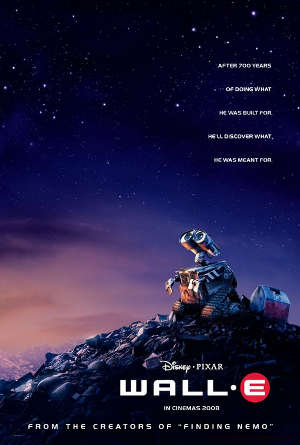- Title: WALL-E
- IMDB: link

 It’s not easy being an animation fan today. It’s obvious that a fraction of the animated film is anything but pure corporate product. Disney has lost its way. AFI named Shrek one of the top ten animated films of all time (WTF?) I might totally give up on the genre if if weren’t for two names – Hayao Miyazaki, and Pixar. In the thirteen years since the latter released Toy Story, the already-legendary picture house has yet to produce a bad film. And after WALL·E, the studio’s ninth and quite possibly best film, all of the shortcomings of the animation industry suddenly seem so easy to overlook.
It’s not easy being an animation fan today. It’s obvious that a fraction of the animated film is anything but pure corporate product. Disney has lost its way. AFI named Shrek one of the top ten animated films of all time (WTF?) I might totally give up on the genre if if weren’t for two names – Hayao Miyazaki, and Pixar. In the thirteen years since the latter released Toy Story, the already-legendary picture house has yet to produce a bad film. And after WALL·E, the studio’s ninth and quite possibly best film, all of the shortcomings of the animation industry suddenly seem so easy to overlook.
Pixar’s always been great at instilling intelligent life in where it doesn’t belong – whether it be in fish, toys or made-up monsters – but never have they been so successful than they are in this film with robots. They’re the most lifeless subject Pixar has chosen to date, and when you throw in the writers’ decision to deny these main characters the ability of speech, it’s all the more impressive. It doesn’t matter that main character WALL·E only has command of two words, he’s still one of the most affecting characters in the history of animation. Through little more than the movement of WALL·E’s claw-like hands and binocular eyes, the animators can communicate more than anyone ever did with Simba or the Little Mermaid.
Perhaps the most impressive aspect of the film is the relationship between the WALL·E and his new lady-love, EVE. Before the first frame is animated, such a love story has plenty going against it – if we have a hard time believing that beautiful Hollywood actors are falling in love with each other in half of the romances that come out anymore (*cough*The Lake House*cough*), how are we to expect fake robots sans dialogue to portray the most base human emotion? Expectations would be low if it were anybody but Pixar were animating it; as it is, it’s 100% authentic and the driving human interest in the movie. Indeed, Keanu Reeves, who starred in a movie I might have mentioned by accident while I coughed a couple of sentences ago, has been beaten by a program from the machine world.
But there’s plenty to love in WALL·E outside of the animation. It’s got all the landmarks of a great Sci-Fi film – dystopic future, gasp-inducing set designs and eye candy, and a moral that easily parallels today’s culture (actually, WALL·E has two of that last point). It brings up big, meaty topics that few family films would dream of touching on; but writer/director Andrew Stanton knows not to become too preachy, and sticks instead to the story.
And just as you would expect any Pixar picture to possess, there’s wealth of humor that can be just as well appreciated by any audience, from a preschool full of antsy toddlers to a prison occupied past maximum capacity with cold-blooded killers.
Movie-goers have looked at Pixar as the king of animation for years now, but any studio that can create as full and touching a vision as WALL·E is clearly more than that – Pixar might well be the best production house in all of Holllywood, animating or otherwise. We might not have too much to celebrate over when it comes to American animation, but Pixar alone is making today a Golden Era of the genre.

Comments are closed.